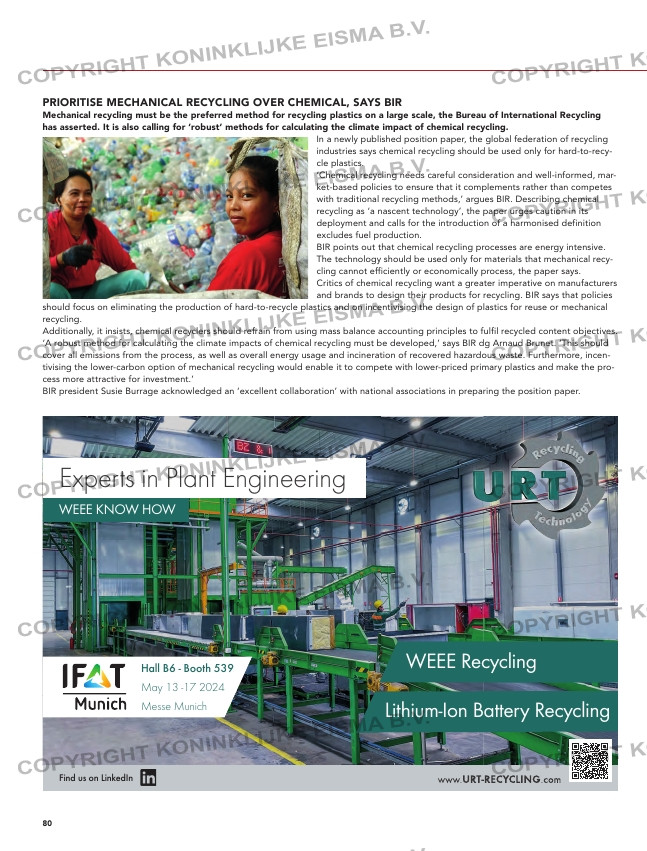Page 80 from: What’s inside?

80
US BACKS BOREALIS’ PCR PRODUCTS FOR FOOD
CONTACT
Austrian chemical outfit Borealis has won US approval for the
use of its post-consumer recycled product Borcycle M in food-
grade packaging.
The company has announced that it has received Letters of No
Objection (LNOs) from the US Food & Drug Administration
(FDA) concerning the use of certain HDPE and PP grades.
It says the LNOs pave the way for Borcycle M-derived materials
to be used in specific applications in the US, including cosmetics
and personal care as well as food contact. It hopes the approval
will persuade the EU to follow suit.
Under the ruling, up to 100% of PCR high-density polyethylene
and polypropylene can be used in certain dry food contact appli-
cations. They can also constitute up to 10% of packaging for dry
foods with surface oil and moist bakery products.
‘Our customers will be able to expand the use of value-added,
recycled plastics within their portfolios,’ says Jonatas Melo,
Borealis vp for Performance Materials.
‘This FDA clearance
of selected grades of
our Borcycle M port-
folio for food-grade
applications will help
them achieve their
sustainability targets
and bring us all clos-
er to a fully circular
economy for plastics.’
THM REPLACES ZM GRANULATORS WITH PG
RANGE
THM Recycling Solutions (THM) is launching a new generation
of power granulators to replace its ZM machines.
The PG power granulator is said to share the same robustness as
ZM but with lower maintenance costs, higher throughput capaci-
ties, easier handling and reduced space requirements. It incorpo-
rates features to facilitate easier maintenance and operation, as
well as increased throughput performance for shredding metals,
cable scrap, plastic waste etc.
THM emphasises the use of four sieve segments instead of a sin-
gle heavy standard sieve as found in the ZM series.
‘These sieve segments are lighter and easier to replace than a
continuous sieve basket,’ the German company says. ‘In case of
damage to the sieve, only the affected sieve segment needs
replacement, not the entire sieve basket, resulting in optimised
maintenance costs.’
Another new feature is a hydraulically swivelling sieve basket.
Previously, when changing the sieve on the ZM, the discharge
unit had to be removed, requiring at least two people and a
transport trolley. The new sieve basket and segments eliminate
this effort, accelerating and simplifying maintenance while reduc-
ing costs.
The PG granulator has a larger inlet opening to increase through-
put performance by accommodating more material. It is also
sleeker than the ZM machine series, requiring less space.
PRIORITISE MECHANICAL RECYCLING OVER CHEMICAL, SAYS BIR
Mechanical recycling must be the preferred method for recycling plastics on a large scale, the Bureau of International Recycling
has asserted. It is also calling for ‘robust’ methods for calculating the climate impact of chemical recycling.
In a newly published position paper, the global federation of recycling
industries says chemical recycling should be used only for hard-to-recy-
cle plastics.
‘Chemical recycling needs careful consideration and well-informed, mar-
ket-based policies to ensure that it complements rather than competes
with traditional recycling methods,’ argues BIR. Describing chemical
recycling as ‘a nascent technology’, the paper urges caution in its
deployment and calls for the introduction of a harmonised definition
excludes fuel production.
BIR points out that chemical recycling processes are energy intensive.
The technology should be used only for materials that mechanical recy-
cling cannot efficiently or economically process, the paper says.
Critics of chemical recycling want a greater imperative on manufacturers
and brands to design their products for recycling. BIR says that policies
should focus on eliminating the production of hard-to-recycle plastics and on incentivising the design of plastics for reuse or mechanical
recycling.
Additionally, it insists, chemical recyclers should refrain from using mass balance accounting principles to fulfil recycled content objectives.
‘A robust method for calculating the climate impacts of chemical recycling must be developed,’ says BIR dg Arnaud Brunet. ‘This should
cover all emissions from the process, as well as overall energy usage and incineration of recovered hazardous waste. Furthermore, incen-
tivising the lower-carbon option of mechanical recycling would enable it to compete with lower-priced primary plastics and make the pro-
cess more attractive for investment.’
BIR president Susie Burrage acknowledged an ‘excellent collaboration’ with national associations in preparing the position paper.
WEEE KNOW HOW
Experts in Plant Engineering
Hall B6 – Booth 539
May 13 -17 2024
Messe Munich
WEEE Recycling
Lithium-Ion Battery Recycling
Find us on LinkedIn
Anzeige_205x138mm_IFAT Recycling International Magazine 2024_0411_RZ.indd 1 17.04.24 09:35
78-79-80-81-82_trendsupdatesii.indd 80 25-04-2024 09:33



